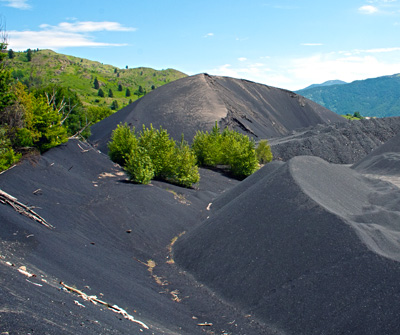City finds solution to slag sinkholes
Work to prevent sloughing of the old mining tailings along the Granby River in Grand Forks is set to start after city council accepted recommendations from experts this week.
A geotechnical report, received by council at their meeting Monday, Jan. 28, outlined strategies estimated at $270,000 for the redirection of Overton Creek and other water management issues near the slag piles located just north of town on the Granby Road. The cost of the project will come from the slag reserve fund the city holds.
“It needs attention rapidly,” said mayor Brian Taylor. “I think that we’re looking at trying to get this done before freshet this year since it was that time last year when we had the degradation under the pile and the issues that developed. To allay some concerns, this is really preventive and cautious on the city’s part and we’re trying not to alarm people – we’re taking a responsible position.”
Large crevices and sinkholes in the slag pile noted in spring of 2012 led the city to engage geotechnical experts in identifying causes and possible dangers. After a preliminary inspection, the city was advised that the crevices (some as wide as two feet across and extending 10 feet vertically) were formed as a result of underground waterways which in all likelihood have been there for some time, but now due, to excessive rain and running water, have become apparent. While there was no initial concern that the problems would impact the Granby River, daily monitoring was implemented.
“Once we move forward with this, we’ll tender the project,” added Doug Allin, chief administrative officer. “We’ll basically divert the water downstream south of the slag pile and then Overton Creek will be re-located into the Granby River at that point.”
The full report, written by Peter Hanenburg, an engineer with Interior Testing Services Ltd., identified short and long term recommendations for the city.
“It is unclear whether the tension cracks, which have been observed for a period of decades, have recently opened,” said Hanenburg in his report. “If the tension cracks have recently increased, it is anticipated that the cause of recent slope creep is most likely due to the significant volume of water that drained through the stockpile this year.”
Potential risks, noted Hanenburg, range from flooding from the river should some of the slag slide down to a large scale failure at a time of high water levels which would have a higher impact but did not indicate that there was any imminent danger.
Accordingly, Hanenburg recommended the city take immediate action to remove the most likely cause of the problem: Overton Creek run-off.
Civil and environmental consultants will be hired to design how to best divert Overton Creek and it will be completed before spring. A detailed survey monitoring program will be started to give more accurate information to city staff on the status of the slag. The city’s fire chief is also in action preparing an emergency plan to deal with large slope failure.
Hanenburg went on to recommend that the city consider draining the slag stockpile should monitoring indicate ongoing movement.
The slag is the waste minerals left after extracting copper for the smelter that was the main industry for the area in the early 1900’s. Pacific Abrasives uses the material for sandblasting products and city crews access the gravel pit nearby.






















